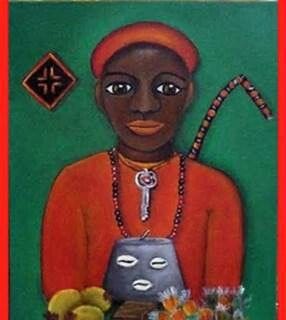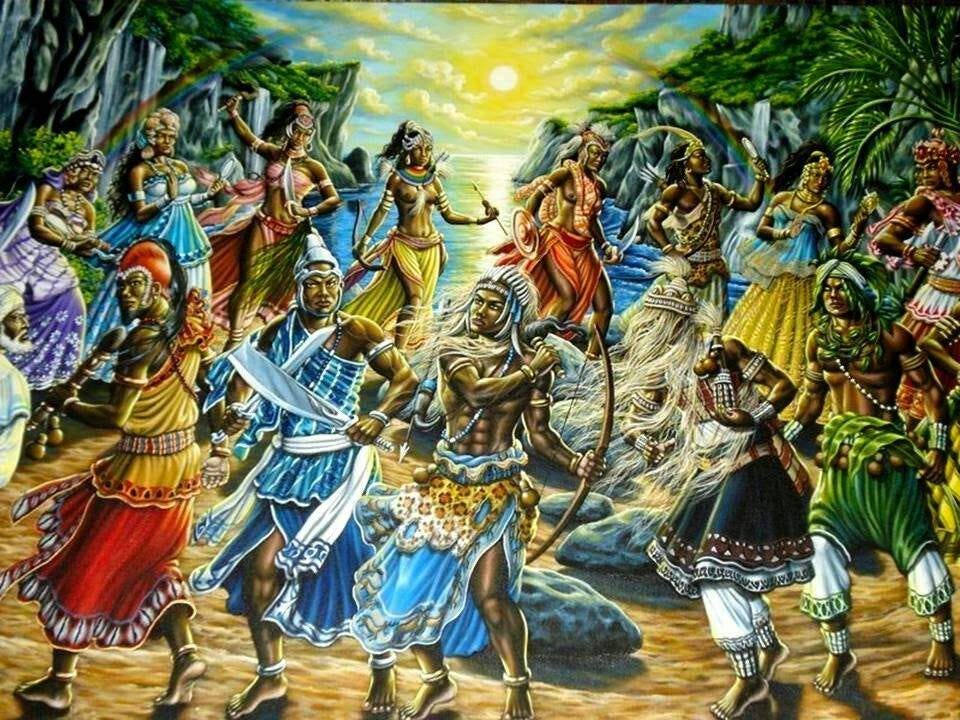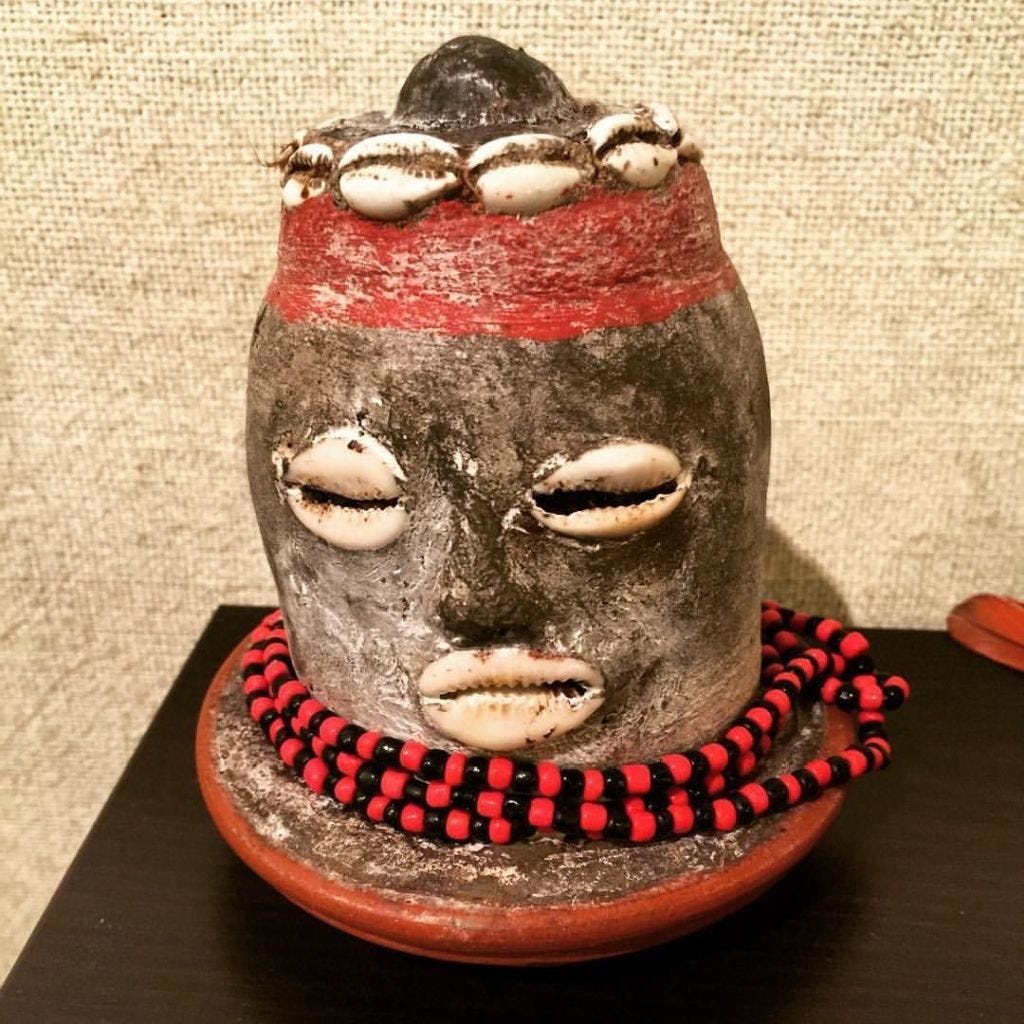Elegguá and the Orishas
Afro-Caribbean deities from the Yoruba religions
I recently came upon a song about Elegguá. Curious, I researched further and found that he is one of the hundreds of Orishas in the Yoruba religions. Although there is no fixed number of Orishas, it is estimated that there are 400, 700, or even as many as 1,440. Many traditions say that there are "as many as you can think of, plus one more - an innumerable number." 401 of them are recognized in the Yoruba pantheon.
The song that inspired this article can be seen below. As a singer and choral director, this genuinely piqued my interest. Enjoy the delicious harmonies and complex rhythmic patterns. This version of Elegguá comes from Cuba (you will notice various spellings of his name based on region).
Yoruba
Originating out of southwestern Nigeria and extending into portions of Togo and Benin. The Yoruba homeland consists of a modern population that exceeds 60 million people. You can learn more about this region and the origins of Yorubaland in the video below:
Orishas
Orishas are known as spirits who reflect supreme divinity. Human-like manifestations of God-like creatures. They are known to have lived as human beings on earth and to have lived in the spiritual world. Some are known as humans who have been recognized as deities as a result of their extraordinary feats. Many orishas were brought to the Americas via the Atlantic slave trade and are now expressed in variations of the Yoruba religion such as: Santería, Candomblé, Trinidad Orisha, Umbanda, and Oyotunji, and more.
Those who follow the Orishas, believe that their lives depend on aligning with one’s ori. Ori translates to head, but spiritually speaking, it means to follow the destiny of one’s soul. This inanimate and living life-force is the power that makes things happen. The prayers and greetings follow this affirmation. Orisha followers focus on obtaining Ashe (divine energy from Olodumare, the creator deity, that comes to fruition through Olorun, ruler of the heavens and the sun - more details in the video above) through iwa-pele (gentle and good character). If they adhere to this, they will experience inner peace and satisfaction with life.
Ashe is sometimes associated with Eshu, the messenger Orisha. Ashe represents the link between the Orishas, the ancestors, and the supreme deity. Brazilian capoeira call it "Axé" and it is used frequently in greetings and as a form of praise in various songs. To say that one has axé is a compliment, meaning that they have a fighting spirit as well as a good energy and attitude.
Pantheon
The orisha are grouped by temperaments and colors. Those who are represented by red or black are considered quick tempered, demanding, and aggressive. Those who are represented by white are considered temperate, calm, and gentle. Oral tradition passes on the knowledge of their temperaments and traits. Each orisha is a ruler over the forces of nature and human endeavors and is recognized through numbers, colors, and foods they prefer. Offerings must consider these aspects to ensure that the orisha recognizes their offering and will come to the aid of those who provided the offering. Some people experience meeting the orishas face to face during a wemilere (drumming ceremony). This is done through trance possession via one or more priests.
The world of the Orishas can be seen in the video below. Elegguá is identified as Exu in the collection of Orishas included in the video. Each can be identified at these particular time stamps:
00:00 - Abertura 1:02 - Exu 2:01 - Ogum 2:59 - Oxóssi 3:54 - Omolú 4:52 - Ossain 5:55 - Oxumarê 6:52 - Nanã 8:00 - Oxum 9:24 - Obá 10:54 - Ewá 12:00 - Iansã 13:06 - Logun Edé 14:21 - Iemanjá 15:18 - Xangô 16:21 - Oxoguian 17:20 - Oxalá
Elegguá
Elegguá is the Deity of roads. He is considered one of the most important Orisha in the Yoruban religion and its American diaspora. He is frequently known by many names including Elegguá, Ellegua, Legba, Elegba, Elewa, Exu, or Eshu. He lives behind all doors and everywhere in nature. As the owner of the crossroads, he is the conduit between the physical and spiritual worlds. He is frequently represented in two forms: as a child and as an old man, representing the beginning and ending of life. This symbolizes the opening and closing of various paths in life as well. He originated out of Yorubaland but has given rise to Santería in Cuba and Venezuela. In Brazil and Colombia, he is tied to Candomblé.

Origin Story
Elegguá was a prince, the son of Okuboro, the King of Añagui. One day, as Elegguá was walking among his entourage, his eyes were struck by a bright light. Upon further inspection, he found the fruit of a coconut tree that had three eyes. Then a voice emerged from the coconut saying, “Take care of me and free me from the insects that want to eat me; if you protect me, I will give you health and prosperity.” Pleased, Elegguá took the coconut with him to the palace. When sharing his story with those in the royal court, many people made fun of the boy. Some even went so far as to throw the coconut around the room, taunting him with it. The King’s advisor suggested hiding the coconut from the boy so that he would forget about it. Three days later, the boy fell ill and died.
While mourning the death of the prince, the court and the people suddenly found themselves in a bad situation. They soon realized that the coconut could be the cause. Since it had been abandoned, bugs had consumed the coconut, and its shell was now empty. A fortune teller was called to assist them. The fortune teller told them that they had offended a good genius who had lived in that coconut. Their treatment of the coconut had angered him, and this is why the prince had died.
The king, repentantly venerated the coconut, asking for forgiveness and protection. However, the genius’ eyes were never to shine again. A soothsayer advised them to put eyes, ears, and a mouth on the coconut so that the genius can hear and talk to us. They found snails to embed on the coconut to give the genius eyes. Then they embedded shells for ears so that the genius could hear their prayers. After adding a mouth, the genius spoke once again. Sharing his wisdom to the ignorant people, he then forgave them.
This is why people started to place a saint’s stone behind the door where the coconut was. Elegguá’s origin as an orisha has evolved into this practice of placing a saint’s stone behind the door, so that he can live there and protect the ilé (house). He is the orisha that opens and closes the astral plane allowing happiness or unhappiness of human beings. He is also the doorkeeper of the savannah and the mountain.
Receiving Elegguá
Elegguá is a child, and as such he likes things associated with the play of children. He is a trickster and likes to play jokes on people. He also enjoys kites, balls, and other toys. He has straw hats and a shepherd’s staff, and likes silver coins, whistles, and keys. His colors are red and black, so he dresses in these colors, often in Spanish colonial-style knee-length pants. Although other traditions have him in white and black, which also demonstrates his contradictory nature. He wears a red hat or kerchief, or a straw hat. He dances playfully and wants attention from onlookers. His food preferences include candy, toasted corn, coconuts, smoked hutia meat, smoked fish, and red palm oil. The elder version prefers cigars and aguardiente (strong alcohol) or vino seco (white wine). His offering day is Monday and the third day of the month. His numbers are 3 and 21 (or any multiple of 3). January 6th and June 13th are recognized as Elegguá “saint’s day” in Cuba. A feast is given in his honor. The Catholic religion has syncretized him with the Child Jesus of Atocha, Saint Anthony of Padua, and the Anima Sola (soul in Purgatory).
His role is to stand at the crossroads between the human and the divine. As a child-like messenger between worlds, he has a close relationship with Orunmila, the orisha of divination. Elegguá is the orisha that must be called upon before any other orisha as he is the one who opens the door between worlds and the different roads in our lives. As a powerful orisha, he is one of the Warriors (along with Ogún, Ochosi and Osun). He is mentioned first in any ceremony as his permission is required for any doors to communicate with other Orisha remain closed without it.
Prayer for Eleggua: Echu obá loná tosí gbogbo ona iré o aché
Through a special ceremony, Elegguá is received alone or with other warriors. In the ceremony, a stone is used to represent Elegguá. The stone is prepared (covered with cement) and charged with the orisha’s aché. The stone is shaped into a head and cowrie shells are used for the eyes and mouth. He is then placed into a clay dish behind a door. Elegguá's eleke (beaded necklace) is an alternating pattern of red and black beads. The colors and design represent life and death, war and peace, and the beginning and ending of all things.
Elegguá plays a central role in every decision made in life. He can make things go smoothly or put obstacles in our paths. It is important to maintain a good relationship with him because without him, nothing is possible.
Eshu
Eshu is like Elegguá's shadow or his reflection in the mirror. They are two sides of the same coin, but with separate identities. Eshu is more unpredictable and is not kept in the house. He lives outside of the house, usually in a garden or in a small space near the side of the front door. Eshu’s tricks can be unpleasant or harmful and some non-practitioners have referred to him as the devil, which he is not. He is very powerful and should not be stirred up. He can however, be calmed by food, so people do place a wooden bowl of food scraps outside of the house for him. He works in tandem with Elegguá to keep balance in life. He is not an independent orisha, but rather a part of Elegguá. He is important because without understanding the dark, we can never appreciate the light.
Elegguá’s Roads
Elegguá has 101 roads at his disposal. Each road signifies a different personality of his. Each of these roads are found in different places in nature. He allows roads and doors to open, facilitating destinies and providing fate to change at will. He can also test one’s integrity to find out if they are honest before granting their desires.
One such road is Laroyé Eleguá, a dancer and lover of money. This childlike path is famous for gluttony, maliciousness, and spoiled behavior. He likes sweets as equally as toys, cigars, rum, and brandy. A popular offering is corn balls with honey and guava.
The opposite, Eshu Laroyé is wise and warns of any dangers that come to the house. He is a protector of the house and a wise business advisor. His natural road is found in rivers. He is the guardian of children (especially orphans), beggars, and the homeless.
Below is a video showing a dance for Elegguá.
I hope you enjoyed learning about the Yoruba culture, the orishas, and more specifically about Elegguá. There are many more stories relating to this orisha and his relationship with the other orishas, which can be found at the website links below.
References
Meet Eleguá: characteristics, rites, prayers, qualities and more
Elegua: Who it is, Characteristics, History and More - Oshaeifa.com
Conoce la Historia: Historia de Eleguá
25 Fascinating Facts About the Yoruba Tribe You Didn’t Know - Cultures of West Africa
Yoruba Culture | Origin, History, Beliefs, Religion & More » PIECE — WITHIN NIGERIA





